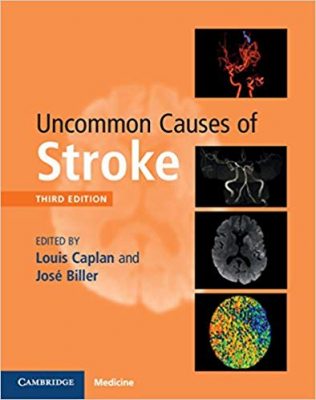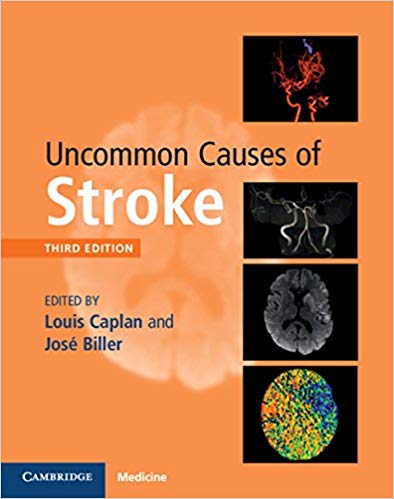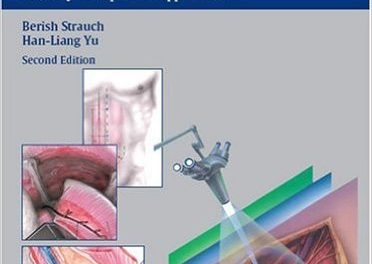 Editors: LouisCaplan, MD and Jose Biller, MD
Editors: LouisCaplan, MD and Jose Biller, MD
Publisher: Cambridge University Press – 644 pages
Book Review by: Sonu Chandiram
This third edition of Uncommon Causes of Stroke has a history going back to about a quarter of a century. The material covered in this book is extensive and the subjects and topics discussed and illustrated in it are exhaustive and wide ranging. This book is also authoritative with experts on particular aspects of strokes located all over the globe having specialized training, experience, insight and understating that are the hallmarks of successful physicians.
One hundred twenty-seven specialists in various fields within neurology and other areas of medicine and surgery authored the 77 chapters of this large book on cerebrovascular diseases, particular strokes, with emphasis on their uncommon causes. They are from all over the United States and 16 other countries, namely Belgium, Brazil, Canada, Ecuador, France, India, Israel, Italy, Japan, Portugal, South Africa, South Korea, Spain, Switzerland, Taiwan and Turkey.
This third edition of the book was published in 2018. The first edition was published almost two decades ago in 2000 and a second one followed in 2008. The onward march of research and technology leads to new findings and knowledge which lead to new experiences and deeper insight among practitioners.
So it is not surprising that the second edition with 560 pages was more than 40 percent longer than the first one that had 391 pages. This current third edition with 644 pages is almost two thirds larger than the original first edition.
The number of chapters and contributors has also grown since 2000, as new knowledge leads to greater specialization, making it difficult and impractical for a single individual to keep up with new findings and acquire new skills.
The idea and the need for Uncommon Causes of Stroke originated after the publication in 1995 of Stroke Syndromes that had three Parts, namely Stroke Syndromes and Signs with 24 chapters, Arterial and Topographical Syndromes with 19 chapters, and Particular Vascular Etiologic Syndromes with 16 chapters. That book had 510 pages and 59 chapters. “That was clearly too much information to include in one volume,” writes Dr. Louis Caplan in the Preface, so this book – Uncommon Causes of Stroke – was born.
The first edition in 2000 had 48 chapters with 71 people contributing to it. The second edition in 2008 grew to 70 chapters with 110 contributors authoring the chapters, and this third edition is even larger and more specialized, with 77 chapters and 130 writers. The chapters are organized around nine Sections, namely:
- Section I – Infectious Conditions
- Section II – Inflammatory Conditions
- Section III – Hereditary and Genetic Conditions
- Section IV – Vascular Conditions of the Eyes, Ears, and Brain
- Section V – Disorders Involving Abnormal Cogulation
- Section VI – Systemic Disorders That Also Involve the Cerebrovascular System
- Section VII – Non-Inflammatory Disorders of the Arterial Wall
- Section VIII – Venous Occlusive Conditions
- Section IX – Vasoplastic Conditions and Other Miscellaneous Vasculopathies
In this book, you will find information on numerous anomalies, conditions, diseases, disorders, syndromes, and other topics, including and not limited to:
Amaurosis fugax, Angelman’s syndrome, apraxia, arachnoiditis, ATR-16 syndrome,
Behcet disease, Bell’s palsy, blindsight, Blue Rubber Bleb syndrome, Brody myopathy
Canavian disease, Chagas disease, Charcot-Marie-Tooth disease, Cogan syndrome, cysticercosis,
Dandy-Walker syndrome, Dejerine-Klumpeke palsy, Dravet syndrome, Duchenne dystrophy
Ehlers-Danlos syndrome, empty cella syndrome, enuresis, Erb’s palsy, erythromelalgia,
Fabry disease, Fahr’s syndrome, Febrille seizures, Foville’s syndrome, Fisher’s syndrome
Gaucher’s disease, Gertsmann’s syndrome, giant cell arteritis, globoid cell leukodystrophy
Hemicrana Continua, Hirayama syndrome, Hirschsprung’s disease, Holmes-Adie syndrome,
Inclusion-body myositis, intravascular lymphoma of the CNS, incontinent pigmentia
Joubert syndrome
Karak syndrome, Kawasaki disease, Kearns-Sayre syndrome, Kleine-Levin syndrome
Lafora adidease, Lambert-Eaton myasthenic syndrome, Landu-Kleffner syndrome, lissencephaly
Machado-Joseph disease, Melkerson-Rosenthal syndrome, Mobius syndrome, Marfan syndrome
Neuro-Behcet’s disease, neurosarcoidosis, Niemman-Pick disease, non-4 sleep-wake disorder
Ohtahara syndrome, Osler-Weber-Rendu disease, O’Sullivan-McLeod syndrome, otosclerosis
Palinopsia, Parkinson’s disease,Parry-Romberg syndrome, Pelizaeus-Merzbacher disease
Quadrantanopia, quadriplegia
Ramsay-Hunt syndrome- type I, II, and III, Refsum disease, Rett syndrome, Reye’s syndrome
Saint Vitus dance, Sandhoff disease, Schilder’s disease, Sturge-Weber syndrome, spina bifida
Takayasu disease, Tay-Sachs disease, Thomson disease Todd’s paralysis, Tourette syndrome
Unverricht-Lundborg disease, uveo-cerebral vasculitic syndromes
Varicela zoster virus , vertebral artery dissections, Visual Snow, Von Hippel-Landau disease
Wallenburg’s syndrome, Wernicke’s encephalopathy,West syndrome, Wyburn-Mason syndrome
X-rays of aortic dissections
Y-linked hearing impairment
Zellweger’s syndrome, Ziehl-Neelsen stain
This is an excellent, detailed, well-developed volume on cerebrovascular diseases and disorders with an emphasis on the not-so-usual and not-so-obvious causes of strokes.
Editors:
Dr. Louis Caplan is Professor of Neurology at Harvard Medical School and Senior Physician on the Beth Israel Deaconess Medical Center Stroke Service. Previous chair of the Stroke Council of the American Heart Association and chair of the Boston and Chicago Neurological Societies, he is also an honorary member of the Australian, German, and Hong Kong Neurological Societies and the South Korean Stroke Society.
Dr. Jose Biller is Professor of Neurology and Neurological Surgery and Chairperson of the Department at Loyola University in Chicago. Director of the American Board of Neurology and Psychiatry (1994-2001) and President in 2001, Dr. Biller is a fellow of the American Academy of Neurology, American Neurological Association, American College of Physicians, and the Stroke Council of the American Heart Association.







